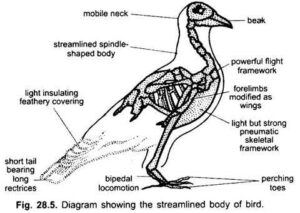Back to: ZOOLOGY 300 Level
Welcome To Class!
Hi there, superstar! It’s such a joy to have you back in class. Have you ever wondered how birds manage to fly so gracefully or how bats can find their way in total darkness without bumping into things? Well, today we’ll learn the science behind those wonders, and trust me, you’re going to love every bit of it!
Flight Adaptations In Birds, Echolocation In Mammals, Etc.
Flight Adaptations in Birds
Flying isn’t easy—it takes strength, lightness, and balance. Birds are specially built for flight, with every part of their body working together to make flying smooth and efficient.
Some key flight adaptations in birds include:

- Lightweight bones: Birds have hollow bones filled with air spaces. This makes them lighter and easier to lift into the air.
- Feathers: Their feathers are strong yet light. Wing feathers help with lift and direction, while tail feathers help with steering and balance.
- Strong chest muscles: Birds have powerful breast muscles (especially the pectoralis major) that control the flapping of wings.
- Streamlined body: Their bodies are shaped like a teardrop—narrow in front and wide in the middle—to reduce air resistance while flying.
- Efficient respiratory system: Birds have air sacs that keep fresh air flowing through their lungs continuously, giving them more energy during flight.
A good example is the eagle. With its wide wings, sharp eyesight, and strong muscles, it can soar at great heights for long hours, using very little energy.
Echolocation in Mammals
Echolocation is a special skill used by some mammals to “see” with sound. It allows them to navigate and find prey in complete darkness.

Here’s how it works:
- The animal makes a high-pitched sound (usually too high for humans to hear).
- The sound travels out, hits an object, and bounces back as an echo.
- The animal hears the echo and can tell how far away the object is, how big it is, and even what it might be.
Bats are the most famous echolocators. Even in the darkest caves or night skies, they can fly through narrow spaces and catch small insects mid-air.
Dolphins also use echolocation underwater to find food and communicate. Their sound waves travel well in water, and their brain processes echoes very quickly.
Other Unique Adaptations
- Owls have silent flight thanks to special feather edges, helping them sneak up on prey.
- Moles, though nearly blind, have sensitive whiskers and skin to detect underground vibrations.
- Whales use low-frequency sounds to communicate over long distances in the ocean.

Summary
- Birds fly because of special adaptations like hollow bones, feathers, strong muscles, and a streamlined body.
- Echolocation is used by mammals like bats and dolphins to navigate and hunt using sound.
- Animals survive and thrive in their environments by developing these smart and unique abilities.
Evaluation
- What makes bird bones special and suitable for flight?
- Name two body parts in birds that help with flying.
- How does echolocation help bats and dolphins?
- What is the role of air sacs in a bird’s respiratory system?
- Mention one non-echolocating animal with a unique sensory adaptation.
Well done, genius! You’ve just explored some of the coolest superpowers animals have—from flying high to “seeing” with sound. Keep asking questions and discovering new things—Afrilearn is right here with you on this amazing journey. See you in the next class, and remember, there’s no limit to what you can achieve!
